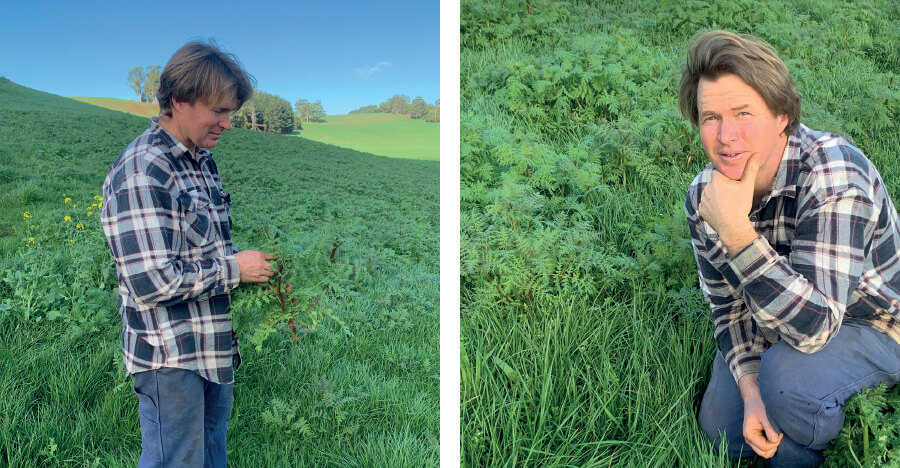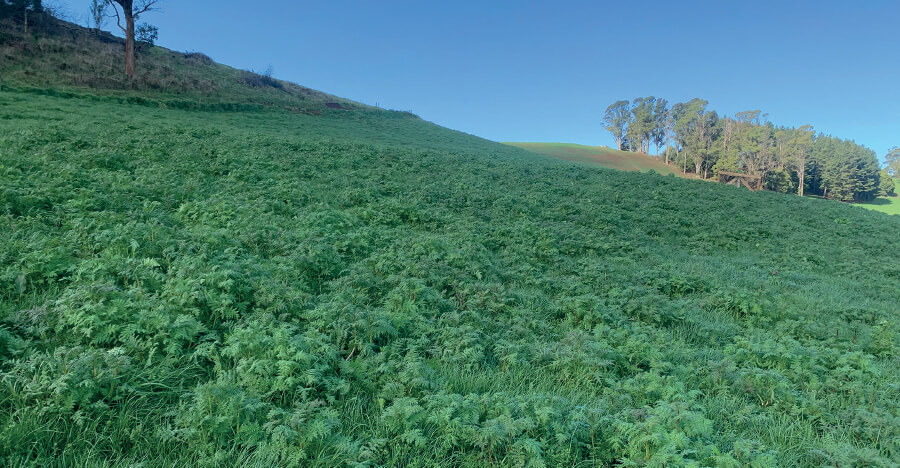
Case
Study
Location
Sunnyside, Tasmania
Crop
Organic dairy
Mark and Roslyn Lambert, Sunnyside TAS
Accidentally organic
Podcast link below
Mark and Roslyn Lambert, along with their nine children, are certified organic dairy farmers from Sunnyside in north west Tasmania. Although their transition from conventional farming to fully certified organic practices was completely unintentional, it’s turned out to be a very rewarding journey. Mark’s passion has become soil health as the foundation for growing nutrient-rich pasture, and lots of it!
Mark and Roslyn Lambert, Sunnyside TAS
Accidentally organic
Podcast link below
Mark and Roslyn Lambert, along with their nine children, are certified organic dairy farmers from Sunnyside in north west Tasmania. Although their transition from conventional farming to fully certified organic practices was completely unintentional, it’s turned out to be a very rewarding journey. Mark’s passion has become soil health as the foundation for growing nutrient-rich pasture, and lots of it!

Organic dairy farmer and soil health advocate, Mark Lambert
Background
Mark grew up on the family farm and has been involved in the dairy industry for over 20 years. He and Roslyn run 560 organic dairy cows and young stock on 390ha of undulating land that receives an average annual rainfall of 1,000mm. To ensure there is quality pasture all year round, three-quarters of the farm’s 190ha dairy platform is irrigated. Overall, around 80% of the farm is dedicated to pasture, with the rest being dams and natural bushland set aside for the benefit of the environment and nature.
The journey from conventional farming, transitioning to biological practices before finally becoming certified organic, was triggered by Mark and Roslyn wanting to solve a problem impacting their herd. That problem was hypocalcaemia (insufficient blood calcium), or milk fever. Not satisfied with advice from the Department of Primary Industries and wanting to prevent animal health issues rather than simply manage them, Mark started his own investigations.
Through his research and own trials, Mark began to deeply understand the symbiotic relationship between healthy soil, healthy plants, and healthy animals, unconsciously embarking on a 10-year transition to organic certification.
“The soil is the building block of our large-scale dairy operation, get that foundation right and everything else starts to fall into place.”
Step 1: Mindset
Mark said, “One of the biggest challenges in the conversion process is changing your mindset – looking to do the same thing as before but using different methods and inputs that are more in step with natural processes. There were lots of synthetic products I no longer could use or wanted to use, but equally, there was a whole new world of inputs that I could, and I had to get my head around that change of thinking and get past the fear of change too.
“My best advice for others looking to transition away from chemical reliance is not to be afraid of new ways of doing things. Learn and embrace the opportunities that nonconventional, more natural practices provide. Regenerative, biological, and organic methods are all tried and tested farming practices these days, just as they were in the past before the introduction of chemical inputs post WWII, but now much more precise,” said Mark.

An organic smorgasboard – Dandelion, Plantain, Vetch, Sheeps Burnett, Red Clover, Chicory, Phacelia
Step 2: Balance within your soil
Healthy soils are a result of first, getting the soil pH right and second, getting the right balance of macro and micronutrients. Soil testing is an essential step in determining the health of your soil, by identifying the presence or absence of key nutrients, organic matter and toxins.
“In the beginning, I learnt that getting your soil right is really important for any farming system; 10 years on and now farming organically, I know it’s absolutely critical. The soil is the building block of our largescale dairy operation, get that foundation right and everything else starts to fall into place,” said Mark.
At the start of the transition, Mark’s soil pH was around 5.6 (in water). He addressed the soil pH issue with applications of lime and dolomite. Mark estimates that all up they have used in the realm of 15t/ha. Today, the soil pH is sitting around 6.7 to 7.0.
Phosphorus (P) and sulphur (S) imbalances were not overlooked. Seeking a natural and sustainable alternative to conventional chemical P and S fertilisers, Mark discovered BioAg’s Superb solid fertiliser made from a high-grade and highly reactive phosphate rock combined with BioAg’s proprietary microbial digesting agent. Superb appealed to Mark as it was a certified organic input, and a more sustainable way to add P and S to his soil along with Calcium (Ca). He applied Superb at the rate of 250kg/ha in biennial applications.
“Our soils have a very high Phosphorus Buffering Index (PBI)* and so Superb was my first choice, with a third of P, S and Ca immediately available and the other twothirds sustainably and steadily released over a 2-3 year period. We’ve only needed to apply Superb every other year which has saved us a lot in input, storage, and application costs, and importantly time,” said Mark.
The long-term P availability in all BioAg’s solid fertilisers supports stronger and healthier plant and root systems and reduces the amount of nutrient susceptible to soil lock-up and leaching. BioAg’s solid fertilisers can be spread at any time of year and are safe to spread near waterways.
“..we are growing more grass organically than we ever did conventionally, with a lot less inputs and greater biodiversity. The grass is greener, taller, and more robust with different plant species at different growth stages, and our cows are much healthier as a result.”

An organic smorgasboard – Dandelion, Plantain, Vetch, Sheeps Burnett, Red Clover, Chicory, Phacelia (image below).
Step 3: Results
Mark and Roslyn’s farm has deep volcanic red soils (Ferrosol, Krasnozem), with ECAC (Effective Cation Exchange Capacity) of 30. They have very high Aluminium, Iron and Manganese problems at a low pH, and a very acidic subsoil.
“The pastures just bloomed with growth once we balanced the soil and got the pH above 6.5. The soil microbes love it, they are the ones that do the work for you, and they are the ones that pull the nitrogen out of the air.”
This year they have resown about 15% of their dairy pastures, thanks to an excellent autumn break last year.
“We grow a fruit salad pasture mix of 18 species, with only two species from the same genes, two different rye grasses, and everything from other species like cocksfoot, prairie grass, phalaris, plantain, chicory, and white, red and sub clovers. This allows the cows to self-medicate and eat what they need for their health, as well as enjoy the variety.
“We also run a 40% longer rotation than industry standard and now we are growing more grass organically than we ever did conventionally, with a lot less inputs and greater biodiversity. The grass is greener, taller, and more robust with different plant species at different growth stages, and our cows are much healthier as a result,” said Mark.
“Our journey from conventional took a bit longer than usual, but I am happy the way that we went about it and how we have succeeded. Our pastures are thriving and so are our cattle, giving Roslyn and I more time to spend with our children.
“There were no organic milk processors when we started the transition, so taking slightly longer has allowed us to do it at our own pace, understanding the process and appreciating the journey; for us it was win-win situation,” Mark concluded.
___________
* PBI – Phosphorus Buffering Index is a measurement of the soil’s tendency to chemically absorb P. The higher the PBI, the quicker and more strongly P binds to soil particles, which means less P available to plant roots.
Read more on the Lambert’s organic journey
Interview with Mark Lambert
Australian Farmers: Telling Our Story – ‘Accidentally Organic’ on Apple Podcasts.
Download case study
Download a PDF version of the above case study.

Recent Comments